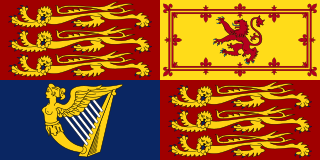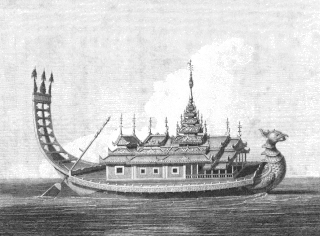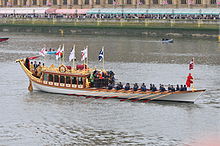
The Royal Standards of the United Kingdom presently refer to either of two similar flags used by King Charles III in his capacity as Sovereign of the United Kingdom, the Crown dependencies, and the British Overseas Territories. Two versions of the flag exist, one for use within Scotland and the other for use elsewhere.

The Company of Watermen and Lightermen (CWL) is a historic City guild in the City of London. However, unlike the city's other 111 livery companies, CWL does not have a grant of livery. Its meeting rooms are at Waterman's Hall on St Mary at Hill, London.
The Keeper of the King's/Queen's Swans was a late medieval-founded office in the Royal Household of the Sovereign of England, later Great Britain and ultimately the United Kingdom. He was earlier called the King's/Queen's Swanmaster. The office existed to perform Swan-Upping marking and health-checking carried out using Thames skiffs on many of the non-tidal reaches of the River Thames in latter years from Sunbury-on-Thames passing Windsor, Berkshire to Henley on Thames. In 1993 it was replaced by two separate offices: Warden of the Swans and Marker of the Swans.

Havengore is a former hydrographic survey launch, originally launched in 1956 for service with the Port of London Authority (PLA). After her withdrawal from service and sale in 1995, she was re-registered as a passenger vessel for up to 40 passengers. Based on the River Thames, Havengore has also served as a ceremonial vessel. She is best known for carrying the body of Sir Winston Churchill as part of his state funeral in 1965.

A waterman is a river worker who transfers passengers across and along city centre rivers and estuaries in the United Kingdom and its colonies. Most notable are those on the River Thames and River Medway in England, but other rivers such as the River Tyne and River Dee, Wales, also had their watermen who formed guilds in medieval times. Waterman can also be a person who navigates a boat carrying passengers. These boats were often rowing boat or boats with sails. Over the years watermen acquired additional skills such as local pilotage, mooring vessels at berths, jetties, buoys, and docks, and acting as helmsman aboard large vessel.

Jesmonite is a composite material used in fine arts, crafts, and construction. It consists of a gypsum-based material in an acrylic resin. It was invented in the United Kingdom in 1984 by Peter Hawkins.

Mark Lochrin Edwards is an English traditional boatbuilder based at Richmond Bridge in Richmond, London, England. He has constructed several significant reproductions of vintage boats and built the Royal barge Gloriana, the lead ship in the Thames Diamond Jubilee Pageant in June 2012.
Kenneth Victor Dwan is a British former rower who competed in the Olympic Games in 1968 and 1972 and won the Wingfield Sculls six times.

A royal barge is a ceremonial barge that is used by a monarch for processions and transport on a body of water.

Queen Alexandra's State Coach is one of several State Carriages maintained at the Royal Mews, Buckingham Palace. It was built around the year 1865, initially as a plain "town coach". Some 30 years later it was glazed and converted into a State Coach for the use of the Princess of Wales Alexandra.

Established in 1993, Henley Whalers is a group of sailing boat enthusiasts based in Henley on Thames, Oxfordshire, UK.

MV Spirit of Chartwell is a hotel barge owned and operated by Portuguese holiday company Douro Azul for luxury cruises along the Douro river, Porto, Portugal.

The Thames Diamond Jubilee Pageant was a parade on 3 June 2012 of 670 boats on the Tideway of the River Thames in London as part of the celebrations of the Diamond Jubilee of Elizabeth II. The Queen, Prince Philip and other members of the Royal Family were aboard vessels that took part in the parade. The parade was organised by the Thames Diamond Jubilee Foundation, and funded by private donations and sponsorship. The pageant master was Adrian Evans.

Gloriana is a British royal barge. She was privately commissioned as a tribute to Queen Elizabeth II for her 2012 Diamond Jubilee, and was the lead vessel in the Thames Diamond Jubilee Pageant.

The Diamond Jubilee Pageant, also branded The World Comes to Windsor, held between 10 and 13 May 2012 was an equine pageant held in the grounds of Windsor Castle, organised as part of the Queen Elizabeth II's Diamond Jubilee celebrations.

The Gibraltar Diamond Jubilee Flotilla, inspired by the Thames Diamond Jubilee Pageant held in England the previous day, celebrated the Queen's sixty years of reign. The parade of vessels around the British Overseas Territory of Gibraltar on 4 June 2012 was one of numerous events scheduled that year in honour of the Diamond Jubilee of Elizabeth II. The flotilla was hosted by Ocean Village Marina, a marina north of Gibraltar Harbour, on the Westside of Gibraltar. Participation in the event exceeded expectations, with 161 vessels in the flotilla.
The list of Diamond Jubilee Honours 2012 was released on 13 September 2012 and made appointments and promotions within the Royal Victorian Order to recognise contributions to the celebration of the Diamond Jubilee of Elizabeth II in 2012. The Royal Victorian Order is a dynastic order of knighthood recognising distinguished personal service to the Sovereign, and remains in the personal gift of the monarch.

Edwin Hunt was a British waterman who served as a sapper waterman in World War II, and was in 1978, appointed the Queen's Bargemaster.

Edith May is a wooden Thames sailing barge built in Harwich, Essex, in 1906. She was used to carry various cargoes until 1952, when a diesel engine was fitted, after which she was used in various Thames Sailing Barge matches, winning several. She was a museum ship for a time, and was restored in 2010 to offer charter trips on the River Medway. Her winter moorings are at Lower Halstow, where she opens during the weekend as a tearoom.

Garrison Sergeant Major William Daran Gillduff Mott, is a former British Army soldier who was one of the army's most senior warrant officers between 2002 and 2015.




















